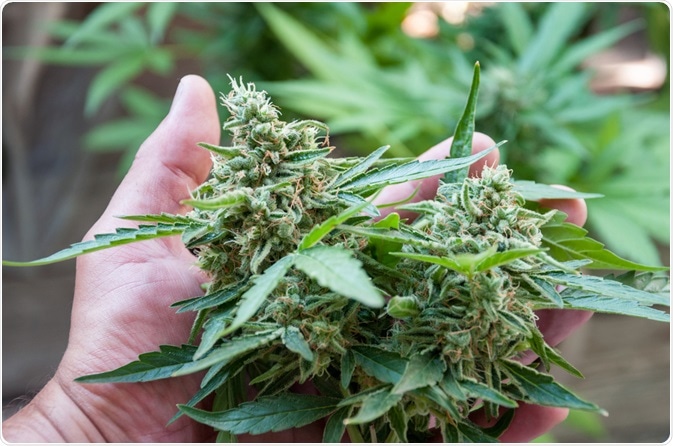DNA analysis provides an enhanced level of reliability for any forensic investigation, including those involving genetically modified and controlled plant species.
To this end, the widespread use of Cannabis around the world has led researchers to advance the current understanding of this plant’s genetic makeup through whole plastome sequencing.

Image Credit: bondgrunge/Shutterstock.com
An overview of Cannabis
The uses of Cannabis, which includes a total of three species known as Cannabis sativa, Cannabis ruderalis, and Cannabis indica, dates back thousands of years for therapeutic, spiritual and recreational purposes.
In today’s world, Cannabis is typically divided into two categories, which include the non-drug type known as hemp, as well as its drug-type, which is otherwise referred to as marijuana. For both recreational and therapeutic uses, the two main cannabinoids of interest include -9-tetracannabinol (THC) and cannabidiol (CBD).
The plastid genome
With certain plant species exists plastids, which are double membrane-bound organelles that are typically involved in the manufacturing or storage of food. About thirty years ago, researchers conducted the first phylogenetic analyses to investigate the DNA of plastids, which ultimately led to the discovery of the plastid genome.
The plastid genome otherwise referred to as the plastome, is extracted from pure plastid DNA (ptDNA) and is typically 120-150 kilobases (kb) in size.
The small size of the plastome, combined with its simple structure, sequence conservation, and uniparental inheritance has allowed researchers to obtain information on the rate of sequence evolution, phylogeny, and traceability of numerous plant species.
Previous data on the Cannabis plastome
Plastomes generally consist of 35,000 to 217,000 base pairs (bp), of which code for between 63 and 209 genes. Previous studies have found that some plastid DNA sequences can be used as genetic barcodes; however, these regions are often insufficient for the identification of subspecies or specific plant strains.
For C. sativa identification, one study suggested that within the rbcL region exists a segment of approximately 561 bp that could potentially serve as this strain’s genetic barcode.
Until recently, the only methods that have been used to discriminate between drug- and non-drug Cannabis types include the analysis of DNA sequence polymorphisms in the THCA synthase gene, gas chromatography coupled with mass spectrometry (GCMS) as well as other chemometric tools, loop-mediated isothermal amplification of the THCA gene and genomic SNP analysis.
Such technology has allowed for the whole plastomes of five Cannabis sativa varieties to be sequenced, of which include C. sativa Carmagnola, C. sativa Dagestani, C. sativa Cheungsam, C. sativa Yoruba-Nigeria, and C. sativa Chinese hemp. Despite the information gained from these studies, there remains a limited ability to successfully characterize Cannabis cultivars.
Whole plastome sequencing of Cannabis methods
A 2020 study conducted by a group of Brazilian scientists characterized the plastomes of two different drug-types of Cannabis that were previously seized by local law enforcement officers.
Whereas one of the samples was considered to be a hybrid, which is a mix of C. sativa, C. indica, and C. ruderalis, the other sample was identified as C. sativa. The DNA analysis of the two samples began with the isolation of whole chloroplasts from both samples, which then underwent DNA extraction. The integrity of the DNA samples was confirmed by the NanoVueTM spectrophotometer, whereas final DNA quantification was achieved through the use of a Qubit Fluorometer kit.
Once the DNA of both samples were isolated, plastome sequencing was achieved through the use of two next-generation sequencing (NGS) strategies including the PGM Ion Torrent, which short reads sequencing, and the Oxford Nanopore MinIONTM method that long reads sequencing.
For reference, the plastid genome of C. sativa Yoruba-Nigeria, which was obtained from the CLC Genomics software, was used.
Conclusion
Several earlier studies have discussed the difficulty in differentiating between drug- and nondrug-type Cannabis by genetic analyses. Like these studies, the current study also revealed similar difficulties, as they were not able to detect neither single nor combined coding plastid regions.
Despite the usefulness that whole plastome sequencing offers for the genetic identification of Cannabis and its hybrids, the researchers concluded that the lack of plastome sequences for both C. indica and C. ruderalis prevented this group from comparing any inter-specific differences of the cpDNA sequences for this sample.
Overall, the researchers anticipate that future plastome analysis of other Cannabis species will contribute to the discovery of genetic barcodes that will allow for true differentiation of drug- and nondrug-type Cannabis samples.
References
- Gitzendanner, M. A., Soltis, P. S., Yi, T., Li, D., & Soltis, D. E. (2018). Chapter Ten – Plastome Phylogenetics: 30 Years of Inferences Into Plant Evolution. Advances in Botanical Research 85; 293-313. doi:10.1016/bs.abr.2017.11.016.
- D’Oliveira Matielo, C. B., Lemos, R. P. M., Sarzi, D. S., et al. (2020). Whole Plastome Sequences of Two Drug-Type Cannabis: Insights Into the Use of Plastid in Forensic Analyses. Journal of Forensic Sciences 65(1). doi:10.1111/1556-4029.14155.
Further Reading